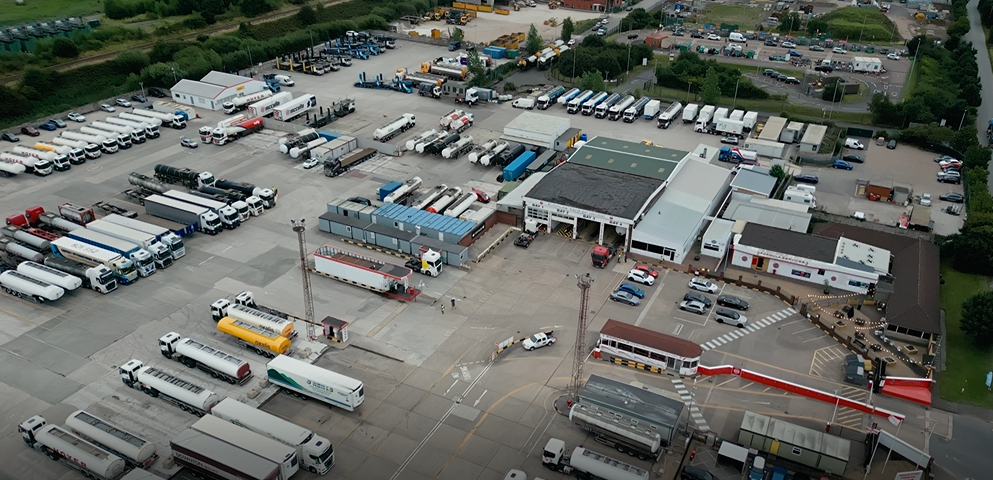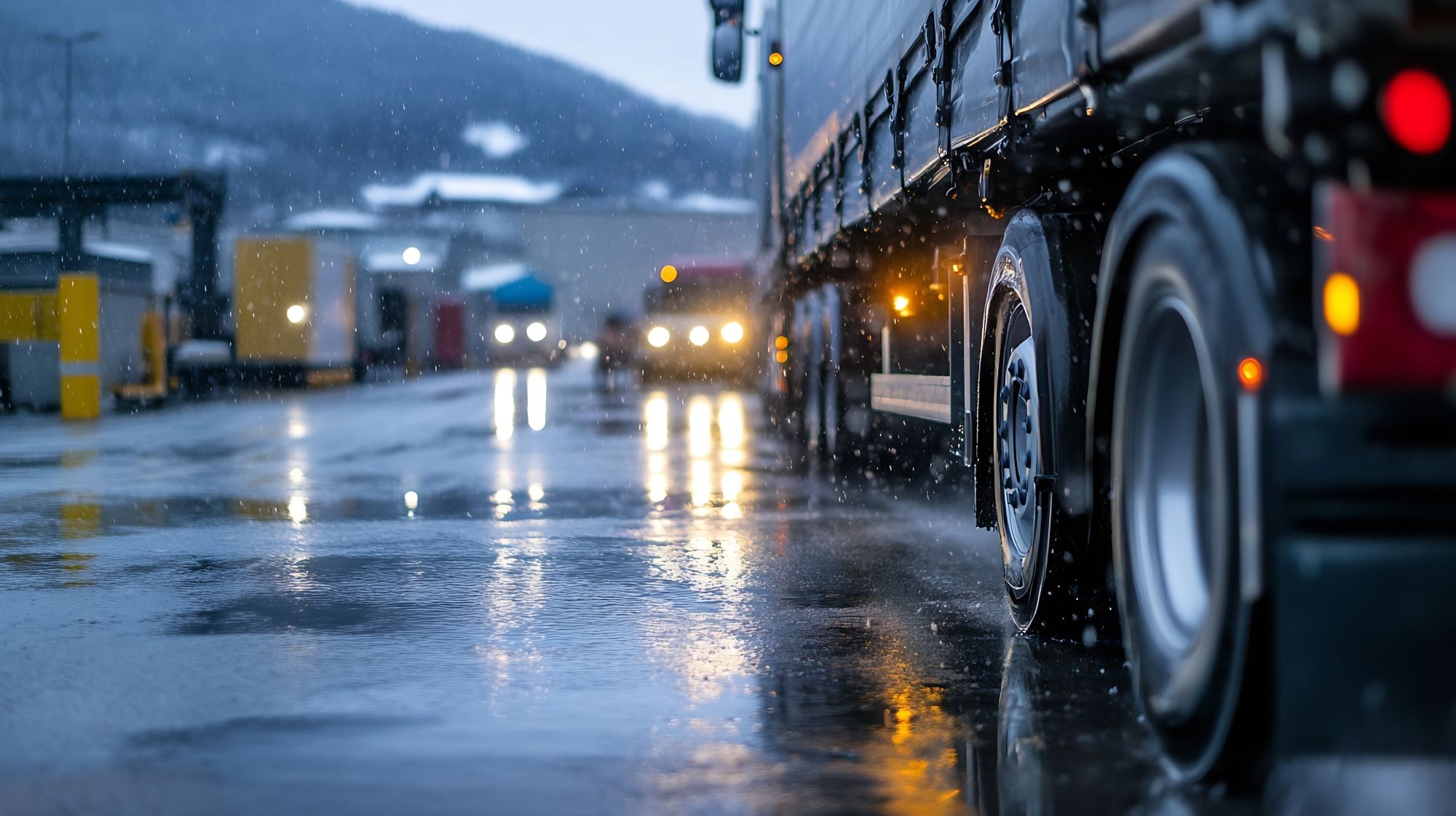
Miranda Blake
Guida per camionisti all'inverno in Europa
Creato: 16/10/2024
•
Aggiornato: 28/08/2025
Gli autisti di camion devono affrontare una serie di sfide e responsabilità uniche nelle stagioni più fredde. C'è un'impennata di incidenti stradali gravi, con il 33% delle richieste di risarcimento assicurativo presentate in questo periodo considerate gravi.
Per questo motivo, la preparazione è fondamentale. Qui vi spieghiamo come gli autisti di camion possono stare al sicuro sia sulla strada che all'interno della loro cabina quest'inverno.
Navigare in condizioni di tempesta
È fondamentale guidare lentamente e mantenere una distanza di sicurezza dagli altri veicoli, soprattutto nelle aree allagate. Dovete mettere la marcia bassa e tenere il motore acceso.
I seguenti consigli sono utili anche per la guida in caso di maltempo.
- Se perdete il controllo in acqua, rallentate rilasciando il piede dall'acceleratore, senza cercare di frenare o sterzare improvvisamente.
- I veicoli più alti sono più vulnerabili ai venti intensi: assicuratevi di tenere saldamente il volante ed evitate i ponti, se possibile.
- Se il vostro camion è vuoto, viaggiate con le sponde aperte. In questo modo, c'è meno da impigliare nel vento.
Gestione di neve e ghiaccio
Anche in presenza di ghiaccio e neve è opportuno procedere a velocità ridotta e mantenere la distanza necessaria dal veicolo che precede. Infatti, si raccomanda di aumentare lo spazio di frenata fino a 10 volte il normale, ma può essere difficile valutarlo. Un'indagine Admiral ha rilevato che il ghiaccio nero causa il 10% degli incidenti in inverno. Si può capire se si sta guidando su ghiaccio nero se la strada sembra bagnata ma non ci sono spruzzi provenienti da altri veicoli.
Altri consigli per aiutarvi a guidare sulla neve sono quelli di sottoporre il camion a regolari ispezioni e di assicurarvi di avere tutto l'equipaggiamento necessario prima del viaggio, come cavi di emergenza e strumenti antighiaccio. Inoltre, è bene tenere sempre presente la marcia da utilizzare, che potrebbe evitare di perdere il controllo del veicolo. Su superfici piane, utilizzate la marcia più alta possibile. In discesa, utilizzate il freno motore e viaggiate con le marce basse. Per evitare lo slittamento delle ruote, usate una marcia più alta quando vi allontanate: in questo modo avrete la trazione necessaria per spostare il veicolo.

Garantire la visibilità
Con autostrade pericolose e fattori esterni che influiscono negativamente sulla visione e causano incidenti con i camion, la visibilità è fondamentale in qualsiasi condizione atmosferica, soprattutto quando fa più freddo. Per questo motivo, assicuratevi di controllare che non vi siano schegge o crepe sul parabrezza, poiché queste possono diffondersi più rapidamente nei mesi più freddi.
Inoltre, è necessario ottenere il massimo livello di visibilità per le luci, la targa e il parabrezza. Oltre a pulire la neve o lo sporco, è bene lavare regolarmente il veicolo per evitare l'accumulo di sale stradale (che provoca la corrosione).
Se la visibilità è scarsa e le condizioni diventano insidiose, è meglio uscire dalla strada e riposare nell'autogrill più vicino. Se alla fine dovrete superare le [ore di guida] (https://snapacc.com/newsroom/discover-the-new-drivers-hours-rules/), potrete utilizzare una dispensa speciale per gli autisti che sono bloccati in circostanze particolari come eventi meteorologici estremi.
Valutazione della profondità del battistrada dei pneumatici
Le basse temperature possono anche influire sulla funzionalità degli pneumatici, in quanto possono provocare una riduzione della pressione dell'aria. Inoltre, i pneumatici usurati aumentano lo spazio di frenata e riducono il livello di stabilità su strade bagnate e ghiacciate.
Di conseguenza, è buona norma controllare la profondità del battistrada prima di ogni viaggio in condizioni di tempesta o altre condizioni avverse: in questo modo sarete consapevoli di quando dovrete affrontare eventuali problemi.
Rispetto delle norme sui pneumatici invernali
È fondamentale conoscere anche le diverse normative sui pneumatici invernali. Alcuni Paesi obbligano gli automobilisti a portare con sé sacchi di sabbia e pale, mentre in altri sono obbligatorie le catene da neve. Continental ha raccolto una semplice [guida ai requisiti dei pneumatici invernali] (https://www.continental-tyres.co.uk/b2c/tyre-knowledge/winter-tyre-laws/) per il Regno Unito e l'Europa.
Dal 1° novembre, i pneumatici invernali sono obbligatori:
- Austria
- Repubblica Ceca
- Finlandia
- Francia
- Lituania
- Serbia
In altri Paesi sono obbligatori verso la fine del mese o a dicembre, oppure dipendono dalle condizioni meteorologiche. Per quanto riguarda i pneumatici chiodati, anche se sono consentiti nei Paesi sotto elencati, ci sono regole severe che li riguardano. È meglio controllare le normative di ciascun Paese prima del viaggio.
- Austria
- Bielorussia
- Danimarca
- Estonia
- Finlandia
- Francia
- Gran Bretagna
- Lettonia
- Liechtenstein
- Lituania
- Norvegia
- Spagna
- Svezia
- Svizzera
- Turchia
- Ucraina
Portare le forniture necessarie
Dovrete anche pensare a come prendervi cura di voi stessi in inverno. Sembrerà ovvio, ma assicuratevi di avere accesso a cibo e bevande sufficienti. Con l'aumento delle possibilità di chiusura delle strade durante le stagioni più fredde, potreste non essere sempre in grado di raggiungere un'area di sosta. Preparatevi con spuntini o pasti e, possibilmente, con una bevanda calda in una borraccia.
Soprattutto se non potete accedere a un luogo di riposo, assicuratevi di poter stare al caldo. Ad esempio, portate con voi degli zaini riscaldanti ricaricabili. Allo stesso modo, tenete sempre a portata di mano indumenti caldi e di ricambio, particolarmente utili se gli indumenti si raffreddano e si bagnano durante operazioni come la rimozione della neve dal parabrezza.
L'ideale sarebbe avere un kit di sopravvivenza invernale, composto da cibo, bevande, un caricabatterie portatile, una torcia, coperte, un giubbotto antiproiettile, una pala e scarpe da trekking resistenti.
Garantire l'accesso alle aree di sosta con intruck
Anche se le condizioni meteorologiche non sono sotto il vostro controllo, proteggete voi stessi e gli altri sulla strada. Per questo è necessario assicurarsi di avere un posto sicuro e protetto dove parcheggiare il prima possibile. La nostra app intruck o la [pagina delle mappe] (https://snapacc.com/map/) vi indicheranno i fornitori di servizi nelle vicinanze e le informazioni sulle strutture offerte da ciascuno.
È possibile scaricare l'applicazione intruck oggi stesso facendo clic su [questo link] (https://intruckapp.com/download/).



